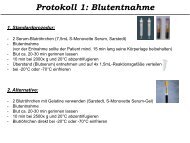CLINICAL TRIAL PROTOCOL SPACE 2 Stent ... - SPACE-2 Studie
CLINICAL TRIAL PROTOCOL SPACE 2 Stent ... - SPACE-2 Studie
CLINICAL TRIAL PROTOCOL SPACE 2 Stent ... - SPACE-2 Studie
Create successful ePaper yourself
Turn your PDF publications into a flip-book with our unique Google optimized e-Paper software.
Clinical Trial Code: <strong>SPACE</strong> 2 Version: 10. October 2008 Final<br />
disease, it seems adequate and timely, to compare state of the art medical prevention<br />
with the interventional therapies. For that reason a three-arm trial with a hierarchical<br />
design is chosen. On the first level, a superiority trial of intervention (CAS or CEA)<br />
versus state of the art conservative treatment is designed. In case of superiority of the<br />
interventions, a non-inferiority endpoint will be tested between CAS and CEA.<br />
1.1.1 Evidence<br />
Asymptomatic carotid artery stenosis, per definition, can be found only in the context of<br />
screening examinations. Due to the lack of systematic screening examinations valid<br />
data about prevalence is not known. It is estimated that the prevalence of asymptomatic<br />
carotid artery stenoses >/=50% is around 2-8%, and of stenoses >/=80% around 1-2%<br />
[8]. Moderate to severe (>/=70%) asymptomatic stenosis of the extracranial carotid<br />
artery leads to an increased rate of stroke of approximately 11% in five years [7, 11].<br />
Patients with asymptomatic carotid stenosis, however, are at also higher risk of nonstroke<br />
vascular events. The estimated annual risks of such events in patients with<br />
asymptomatic stenosis are 7% for coronary ischemic event and 4-7% for overall<br />
mortality [14].<br />
1.1.2 Role of conservative treatment<br />
Medical management of patients with asymptomatic carotid stenoses consists of risk<br />
factor modification, antiplatelet medication and careful monitoring of progression or<br />
hemodynamic relevance by ultrasound. Although no primary prevention trials<br />
specifically focusing on patients with asymptomatic carotid stenosis have been done,<br />
these treatment regimens have been the standard therapy for asymptomatic carotid<br />
stenoses in the past and many treatment guidelines still recommend them as therapy of<br />
choice if surgical treatment cannot be provided with morbidity and mortality-rates below<br />
3% [5].<br />
1.1.3 Role of carotid endarterectomy<br />
The Asymptomatic Carotid Surgery Trial (ACST) and the smaller Asymptomatic Carotid<br />
Atherosclerosis Study (ACAS) studied the role of CEA in nearly 5,000 patients with<br />
asymptomatic carotid stenoses (no stroke or stroke-like symptoms within the previous 6<br />
months) [6, 7]. A recent metaanalysis included three trials with a total of 5,223 patients.<br />
In these trials, the overall risk of perioperative stroke or death was 2.9%. For the<br />
outcome of perioperative stroke or death or any subsequent stroke, patients undergoing<br />
CEA fared better than those treated medically (relative risk (RR) 0.69, 95% confidence<br />
_______________________________________________________________________________________________________<br />
Page 11 of 49





